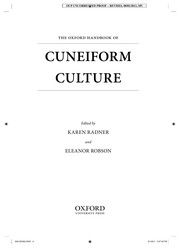Check nearby libraries
Buy this book

"The cuneiform script, the writing system of ancient Mesopotamia, was witness to one of the world's oldest literate cultures. For over three millennia, it was the vehicle of communication from (at its greatest extent) Iran to the Mediterranean, Anatolia to Egypt. The Oxford Handbook of Cuneiform Culture examines the Ancient Middle East through the lens of cuneiform writing. The contributors, a mix of scholars from across the disciplines, explore, define, and to some extent look beyond the boundaries of the written word, using Mesopotamia's clay tablets and stone inscriptions not just as 'texts' but also as material artefacts that offer much additional information about their creators, readers, users and owners"--
Check nearby libraries
Buy this book

Previews available in: English
Showing 2 featured editions. View all 2 editions?
| Edition | Availability |
|---|---|
|
1
Oxford Handbook of Cuneiform Culture
2020, Oxford University Press
in English
0198856032 9780198856030
|
zzzz
Libraries near you:
WorldCat
|
|
2
The Oxford handbook of cuneiform culture
2011, Oxford University Press
in English
0199557306 9780199557301
|
aaaa
Libraries near you:
WorldCat
|
Book Details
Table of Contents
Edition Notes
Includes bibliographical references and index.
Classifications
The Physical Object
ID Numbers
Community Reviews (0)
Feedback?| September 21, 2021 | Edited by ImportBot | import existing book |
| August 2, 2020 | Edited by ImportBot | import existing book |
| July 6, 2019 | Edited by MARC Bot | import existing book |
| October 27, 2011 | Edited by LC Bot | import new book |
| July 27, 2011 | Created by LC Bot | import new book |










